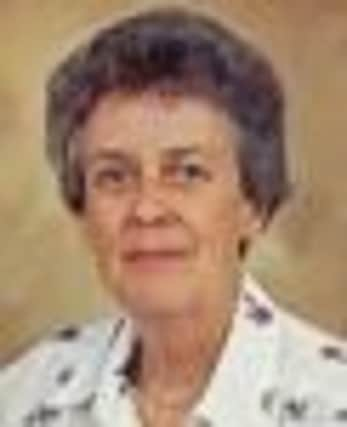Obituary: May Nicol, teacher


The description was shared by almost everyone who knew May; pupils, parents and colleagues alike.
Born in Dollar in 1929, May was Dux of Dollar Academy in 1945, the same honour won by her sister Beth in 1943. The academic excellence she displayed at school was soon matched at St Andrew’s University from where she graduated with a first class Honours in modern and mediaeval history and where she impressed all who taught her with her intellectual rigour.
Advertisement
Hide AdAdvertisement
Hide AdAs a result, she was offered a Carnegie Scholarship but she turned this down straight away since she had already made up her mind that she wanted to teach.
Having done her teacher training in Dundee, her first post was in the history department at Sutton Coldfield High School in 1951 from where she went to Roundhay High School for Girls’ in Leeds as assistant head of department in 1954. In both schools, even as a relatively young teacher, she was an outstanding success.
In 1956, May expressed a wish to return to Scotland to be closer to her parents at a time when her mother’s health was failing, and so it was opportune that the post of head of history fell vacant at Craigholme School in Glasgow. It was during this period that May established herself as one of the leading teachers of history in Scotland and it was little surprise that she was encouraged to apply for the head of history at George Watson’s Ladies’ College in 1960. Throughout the interview process, she faced some stiff opposition, but the headmistress, Hilda Fleming, later disclosed that May’s abilities shone through, and that there was never really any possibility of her appointing anyone else. Certainly, it was not long before she became a very senior and highly respected member of the common room and the member of staff with special responsibilities for the sixth form.
Her teaching of history, her expectations of high standards, and her interest in learning in all its dimensions won her respect everywhere.
She was a firm disciplinarian and she could be candid in her views, yet she also had a strong sense of fairness and of the need to balance school rules and tradition with common sense – something which provided her with a very healthy disregard for bureaucracy and political correctness. She also had wit and a wonderfully comical style of her own when things didn’t quite go to plan.
The amalgamation of George Watson’s Ladies’ College and George Watson’s College took place in 1974 and Roger Young, principal of the combined school, appointed May as one of his two deputies.
He had, he said, no hesitation in making this appointment, given May’s profound influence on the school community both inside and outside the classroom; a sentiment that was echoed by his successor, Frank Gerstenberg.
Both men knew instinctively that, in May, they not only had the finest professional colleague, but also someone who would provide unfailing loyalty and the calm authority to cope with whatever crisis might unfold.
Advertisement
Hide AdAdvertisement
Hide AdThey knew too that if they had to be away from school, no-one would notice their absence – such were the exceptional capabilities of May. Indeed, it is hard to overstate her influence throughout the merger of the schools and the subsequent years of transformation.
The fact that May chose to stay at Watson’s despite being sought out for headships elsewhere is testimony to her deep trust in the Watson’s community.
Yet, if May’s life was, by both choice and necessity, devoted to school, that did not leave her devoid of other pursuits. She relished her travels, particularly those which took her to the many and varied historical sites of her beloved Scotland, and to South Africa to visit her sister; she was a regular and enthusiastic concert-goer at the Usher Hall and the Queen’s Hall, and she was a keen bird-watcher and very knowledgeable on so much else. In retirement, she gave selflessly of her time to the National Museum of Scotland, both as a tour guide and assisting with the membership administration for the Friends of the Museum.
She particularly enjoyed her work with the museum’s silver collection and with various Scottish art collections. In each role, May displayed exactly the same qualities as she had done in her teaching career and it was not long before she became as much of a treasure in the museum as the artefacts she delighted in showing to the thousands of visitors who were part of her guided tours.
May was also committed to charity work, principally working in the Cancer Research UK shop as a member of the Edinburgh Fundraising Committee and at the annual Art Exhibition in Adam House in Chamber’s Street.
She was also a much respected school governor at Lomond School and at George Watson’s College and a valued supporter of the Watson’s Family Foundation.
It is perhaps at the personal level, however, that May will be best remembered. As a teacher, a colleague and as a friend, her advice was invaluable to the many hundreds who sought it.
One never left May’s presence with anything other than the knowledge that she had listened to everything you had to say and that she had acquired a generous understanding of your needs no matter who you were.
The Edinburgh community has undoubtedly lost one of its greatest servants but, nonetheless, May Nicol has left us with an enormous legacy of riches for us all to enjoy.